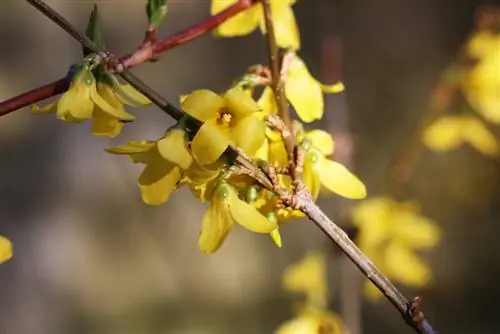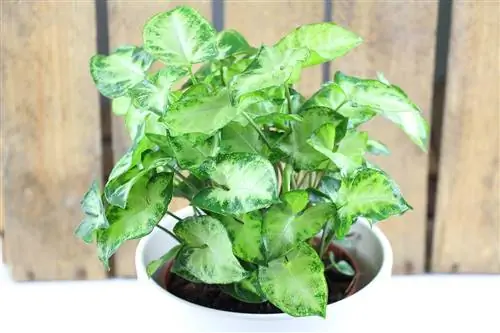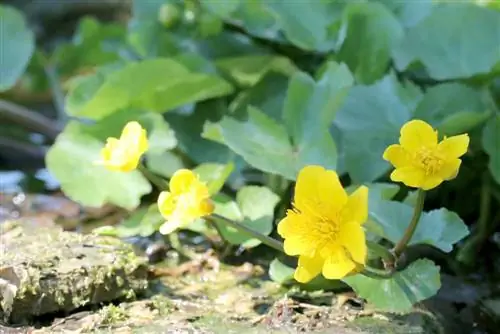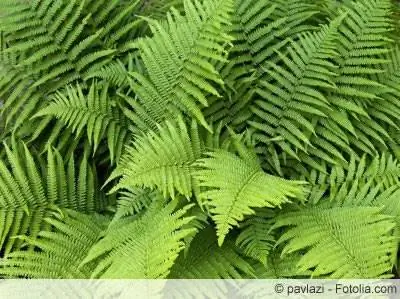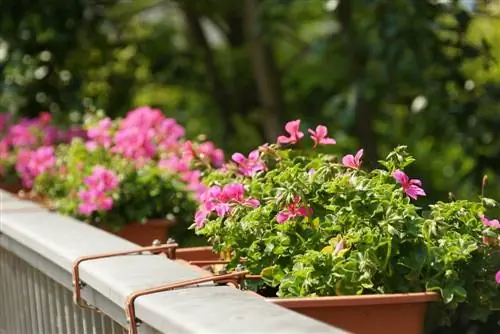- Author admin [email protected].
- Public 2023-12-17 03:39.
- Last modified 2025-01-24 12:45.
Forsythia has long been a popular ornamental shrub in home gardens due to its golden yellow flowers. It is also known as the golden bell and is one of the first plants to bloom in spring. The robust shrub is not particularly demanding in terms of care, but due to its strong growth it does require regular pruning. In addition, Forsythia has little demands on the location and soil conditions. However, the tree requires regular pruning in order to maintain its flowering and he althy growth.
Plan profile
- Ornament for the garden with golden yellow flowers
- Entire ornamental shrub blooms uniformly
- Is ideal as a flowering hedge
- Blooms quite early at the beginning of spring
- Only after the flowering period do the lush green leaves follow
- Reaches growth heights of 1-3 meters, growth width of up to 3 meters
- Plant with robust properties
- Gets along well with other plant neighbors
- Does not place any great demands on care or site conditions
- Does not tolerate high lime levels in the soil
Location & plant substrate
The forsythia has few requirements when it comes to location, as well as when it comes to lighting conditions. However, the golden bell has certain preferences that have a positive effect on growth. In addition, the flowering shrub has strong growing properties; this factor should always be taken into account when selecting the location. Otherwise it can quickly happen that damage is caused by the growth. Due to its distinctive appearance, the ornamental shrub is ideal for a separate position in the garden. The forsythia thrives in a variety of soil qualities, but the plant does not like soil that is too poor in nutrients.
- Prefers sunny to partially shaded locations
- But also tolerates shady places very well
- Plan enough space, especially for neighboring property, buildings and walls
- Ideal as a solitary plant for the front garden
- Hedge planting possible
- Can be used as a privacy screen due to the bushy growth
- Can cope with both nutritious and poor soils
- But prefers nutrient-rich and moderately moist plant substrate
- Don't like soil that's too dry or too wet
- Does not tolerate high lime levels in the soil
Tip:
If the soil around the ornamental shrub becomes too compacted, it should be loosened up with a rake every now and then. In this way, the rainwater can flow away again unhindered and no harmful waterlogging forms.
Plants
The golden bell is relatively resilient and can cope with many site conditions. However, the ornamental shrub begins to rot relatively quickly if the roots are permanently in soggy soil. Therefore, the soil should be well prepared before planting to permanently prevent waterlogging. In addition, a sufficiently large distance from other garden plants must be maintained so that the ornamental shrub can spread.
- Planting possible in both autumn and spring
- The best time, however, is spring, after the last frosty nights
- For free-standing individual plants, plan a distance of one meter from the neighbors
- Dig a planting hole at the location, approx. twice the size of the rootstock
- Create drainage to prevent waterlogging
- Loose up the soil in the planting hole and cover it with a layer of gravel and/or pottery shards
- Then lay out a thin layer of garden soil, mix with horn shavings and compost
- Place the forsythia in the middle, dig in with enough soil and press down
- At the end, pour well
hedge planting
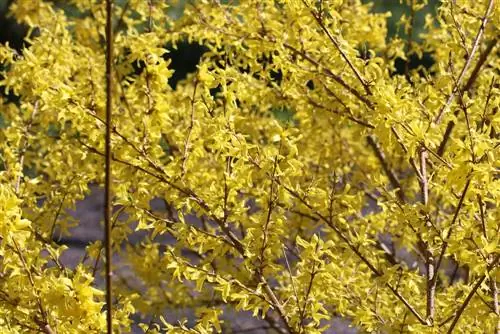
Due to their bushy growth, forsythia are perfect for creating a hedge. With good care and regular pruning, the plant rewards the gardener with a flowering wall that shines green after the flowering period. As a hedge plant, the golden bell is a beautiful and environmentally conscious alternative to fences and stone walls.
- Plan a planting distance of half a meter for the hedge
- Maintain enough space to the neighboring property
- Prepare the soil in the same way as for the individual plant
- Avoid waterlogging and soil that is too dry
Container Planting & Repotting
The forsythia can also be cultivated as a container plant, but then the plant will not be as large as in the garden. Nevertheless, the ornamental shrub retains its strong growth and therefore needs to be repotted after a while. In addition, when kept in a container, the plant becomes more sensitive to low temperatures in winter and therefore needs additional protection during this time.
- Container should be large enough to accommodate growth
- Use either nutrient-rich garden soil or commercial potting soil
- It is essential to avoid waterlogging in the bucket
- Create drainage over the water drainage hole, made of gravel or pottery shards
- Water regularly in the pot, but not excessively
- In winter, wrap the bucket with foil to protect against frost
- Breeding as bonsai possible
Plant Neighbors
The goldbell gets along well with almost all other plants in the garden, so there are no major special considerations when it comes to neighbors. However, the ornamental shrub should not be placed next to other plants whose growth is as strong as yours. Otherwise the plants quickly get in each other's way and the gardener has a lot to do with pruning.
- As an early bloomer, ideal in the neighborhood of late-flowering plants
- Forms a veritable sea of flowers with other early bloomers
- Ideal neighbors are tulips and daffodils
- Looks good next to horned violets and grape hyacinths
Watering & Fertilizing
Forsythia normally do not need to be fertilized, but they do need nutrient-rich soil. If this is not the case, then helpful measures must be taken. The tree is also very undemanding when it comes to watering, but it cannot tolerate conditions that are too dry or too wet.
- In principle no fertilization required
- For nutrient-poor soils, top up with fresh humus once a year
- Alternatively, incorporate compost around the ornamental shrub
- Mulch in extremely sunny and exposed locations
- Soil must not dry out too much
- Normal rainfall is usually enough for the plant
- Water additionally during long dry periods
- Always water moderately, avoid waterlogging at all costs
Tip:
If the soil is very poor in nutrients, it should ideally be fertilized in autumn. During this time, the forsythia is already starting to form buds and is therefore very grateful for additional nutrients.
Flowers & Leaves
The forsythias bloom extremely early because the buds form on the two-year-old branches the previous year. The ornamental shrub is therefore called a harbinger of spring and beautifies every garden with its splendor of flowers. The leaves only develop after flowering, so that the bush then shines in an intense green color.
- Flowering period March to May
- Flowering can vary depending on the variety
- Produces numerous flowers that cover the entire bush
- Golden yellow flowers are approx. 4 cm large, bell-shaped and fourfold
- Flowers appear before the leaves emerge, on the leaf axils of the previous year's branches
- Intensely green leaves form after flowering
- Leaves are up to about 6 cm long and arranged oppositely
Cutting
Forsythia are among the plants with a mesotonic growth habit. In practice this means that the young shoots grow in the middle of the older branches. Therefore, over time, dense and often broom-like branches form on the older branches in the upper part of the tree. This makes the appearance look unsightly and unkempt.
- Branching that is too dense impairs flowering ability
- Oxygen supply and incidence of light are restricted
- Long shoots bend outward in an arc under too much weight
- Woods grow too wide and become bare from below
- Shape cut into a sphere or pyramid possible
- Always use sharp and clean secateurs
Blending cut

Forsythia grows very quickly and tolerates radical pruning very well. However, pruning should be done early, as the tree forms new buds very early. Older forsythia bushes grow bulky and become bare inside over time, then they can only produce a few flowers. Therefore, regular thinning is recommended to improve the light and oxygen supply. Due to the robust properties of the forsythia, no special care is necessary when cutting; even inexperienced hobby gardeners can do this. However, in densely growing hedges, only the protruding branches should be cut back between March and September so that nesting birds are not disturbed while breeding.
- Thin the bush once a year immediately after flowering
- When cutting back, pay attention to the desired shape
- Without pruning, the ornamental shrub loses its ability to bloom
- Only carry out major pruning of hedges after the end of the breeding season
- Short branches by approx. a third of the length
- Lighten the free-standing solitary plant only slightly
- A natural and overhanging growth habit is ideal
Rejuvenation cut
If the shrub has become too large or if a fungal disease occurs, then it can tolerate radical pruning. This results in rejuvenation and the bald or diseased parts of the plant are removed. The ornamental shrub then sprouts uniformly and beautifully bushy again. However, after this extreme rejuvenation cut, the forsythia will not bloom again until the spring after next.
- Needed for lack of space and poor growth
- Cut completely down to the stick
- Leave 4-5 strong shoots
- For weaker plants, divide the pruning over 2 years
- The ideal time is the winter season
- Alternatively also possible in early spring before budding
Wintering
The forsythia is frost hardy and can tolerate even low temperatures without damage. However, the plant becomes more sensitive when kept in a container, so it needs additional winter protection.
- Wrap planters with foil at the start of winter to provide thermal protection
- Do not leave the bucket on the frozen ground
- Use a coaster that protects against frost
- Relocate to suitable winter quarters in extremely sub-zero temperatures
- Frost-free and bright winter gardens, attics, corridors, etc. are ideal.
Propagate
Propagating forsythia is relatively easy; this can be done using planters and cuttings. Cuttings grow roots easily and quickly, a process that only takes a few weeks. It can even happen that the branches of the golden bells take root on their own when they come into contact with the ground. Although sowing hybrids is also an option, the young plants often have completely different characteristics than the mother plant.
- The summer months of July and August are ideal for propagation
- Cut off the woody branch to a length of about 20 cm
- Remove the leaves completely and put them in the ground
- Young bush quickly develops roots
- Relocate next fall
- Use a cold box for sowing
Variety variety
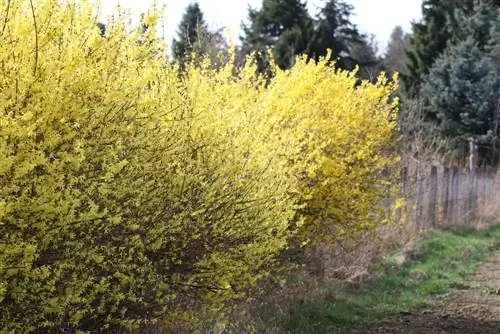
Due to the great popularity of the plant, other varieties are bred in addition to the traditional forsythia. The dwarfs among the goldbells are suitable for small gardens and for keeping in containers. Almost all of them offer the same yellow colors at the beginning of spring, but there are also exceptions to the colors.
- European Forsythia
- Korea Forsythia
- Hanging Forsythia
- Gold Rush
- Girald's Forsythia
- Spectabilis
- Minigold
- Snow forsythia, with white flowers
- Lynwood
- Mikador
- Weekend
Diseases & Pests
Due to its robust properties, Forsythia is largely resistant to diseases and pests. However, the wood begins to rot if waterlogging persists.
Are forsythia neophytes?
This question, which is asked far too rarely, can be clearly answered with“Yes”. Forsythia is one of the “introduced” and non-native plants, which are also called neophytes. It only brings visual added value, unfortunately not an ecological one, as it does not produce nectar that can be used by local bees and is therefore consideredbee-unfriendly. It also does not produce any berries and is only used as an ornamental shrub in this country. However, compared to other neophytes, forsythia has the advantage that it does not spread invasively. This means it only grows where it is planted. With this knowledge, you should consider before planting the next plant whether it might be better to buy a shrub that insects and birds also benefit from. The cornelian cherry (Cornus mas) also has yellow flowers, is friendly to bees and also produces berries that can serve as food for birds.
Conclusion
Due to its medium height, the forsythia is suitable for both individual positions and hedge planting. After the barren winter season, the golden bell with its golden yellow flowers brightly welcomes spring as one of the first plants in the garden. This is why the wood has become so popular in these latitudes. The ornamental shrub only develops its leaves after the flowering period, but they impress with an intense green color and lush growth. The forsythia has only low demands in terms of the quality of the soil, the site conditions and the care steps. However, due to its often sprawling growth, the plant needs regular pruning for thinning, maintenance and rejuvenation. Otherwise, the flowering will quickly diminish and the bush will become bare, creating an unsightly appearance. Since the tree can be propagated easily and quickly, even large gardens can be planted with it in a short time.

